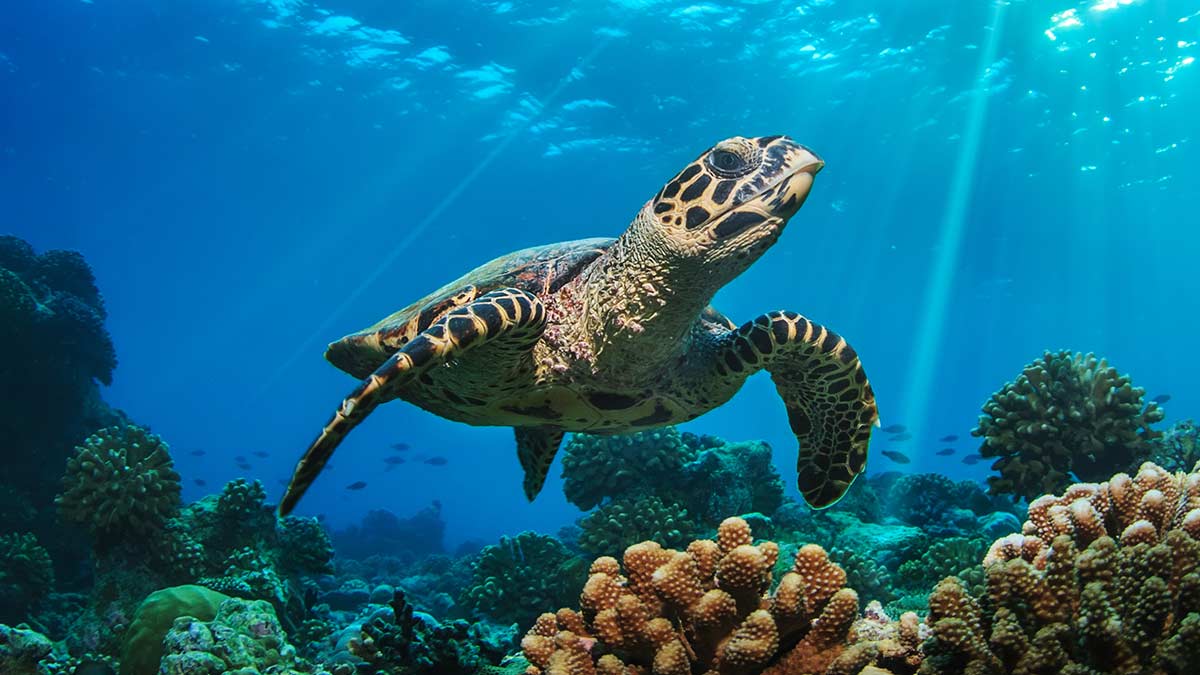Sea turtles have long captivated tourists worldwide. Spotting one of these majestic creatures is often the highlight of coastal vacations. But sadly, sea turtles are rapidly disappearing from our oceans. Six of the seven species of sea turtle are listed as vulnerable or endangered.
This blog explores fascinating facts about sea turtles that will help you distinguish the different species. By learning how sea turtles live, you can better understand how to identify a sea turtle’s species, where to spot sea turtles in the wild, and what they may be doing when you see them.
Sea Turtle Species
Sea turtles can be found in most of the world’s oceans, from as far north as Greenland to as far south as the Cape of Good Hope in Africa. They often migrate across entire oceans, covering thousands of miles to find food, mate, and lay their eggs. Seven species of sea turtles can be found around the world today: hawksbill sea turtles, leatherback sea turtles, olive ridley sea turtles, kemp’s ridley sea turtles, green sea turtles, loggerhead sea turtles, and flatback sea turtles. Although all sea turtles share a common ancestor and behave in similar ways, each species has unique physical traits, diets, habitats, and migration patterns.
Hawksbill Sea Turtle
Hawksbill sea turtles are some of the most recognizable sea turtles on the planet, inhabiting waters in every ocean except the Arctic. They are prized for their unique, mottled shells. This species gets its name from its mouth, which comes to a serrated tip, much like a hawk’s beak. Hawksbills are some of the easiest turtles to identify thanks to their mottled shells, slender, bird-like heads, and mouth shape. Another identifying feature of the hawksbill sea turtle is the ragged, uneven edges on their outer shell sections, which give them an almost jagged appearance.
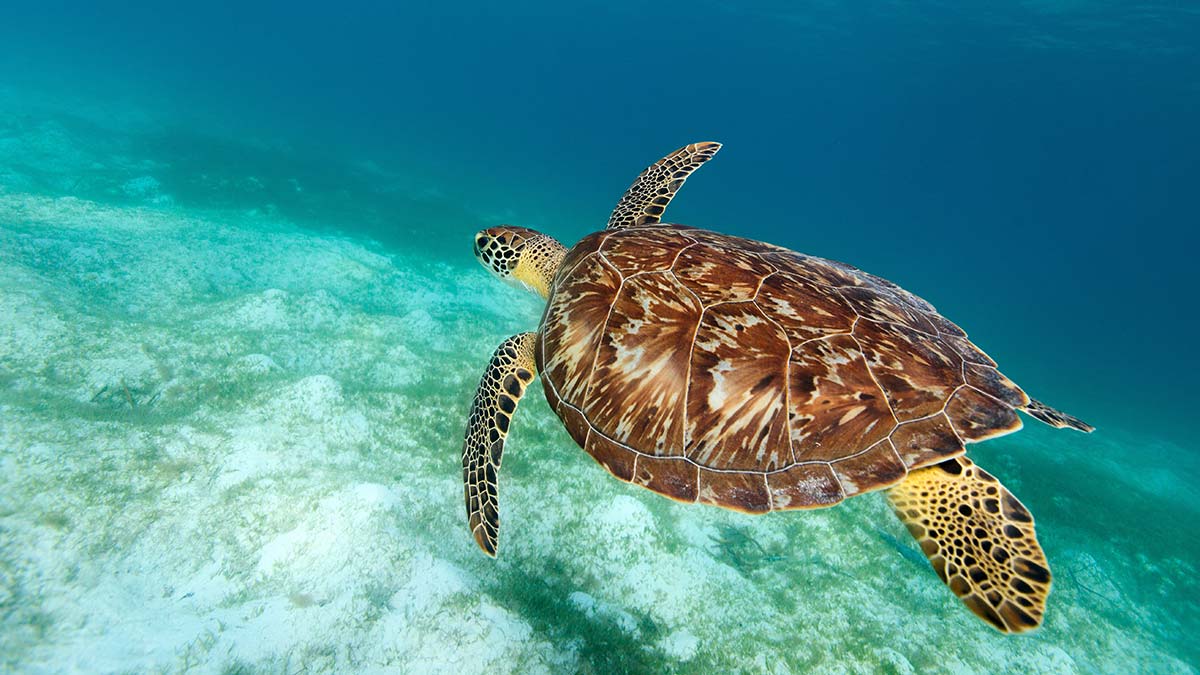
Hawksbills’ sharp beaks are perfectly adapted to scraping their favorite food, sponges, off rocks. While sponges are their preferred meal, these turtles are also known to chow down on crustaceans, corals, marine algae, tunicates (sea squirts), sea urchins, small fish, and jellyfish. Their sharp beaks easily fit into small holes in corals or rocks where they scavenge for these alternate food sources when sponges are scarce.
Hawksbill sea turtles enjoy living in coral reef habitats. You are most likely to find them swimming in the Caribbean Sea, the Indian Ocean, and the Indo-Pacific. Juvenile hawksbills spend most of their time in open ocean areas, floating on algae mats as they drift in the current.
Hawksbills are one of two turtle species classified as critically endangered. Scientists estimate that hawksbill populations have declined by more than 80% over the last 100 years.
Leatherback Sea Turtle
Leatherbacks are the largest sea turtles on the planet, weighing between 500 and 1,500 pounds and reaching an average length of 6 feet. The largest leatherback ever recorded weighed over 2,000 pounds and was 10 feet long.
These sea turtles are the only species on the planet that does not have a hard shell. Instead, leatherbacks have an internal shell consisting of interlocking bones covered in fat and rubbery skin. Their front flippers are proportionally larger than those of their turtle cousins, making them perfectly adapted to travel long distances.
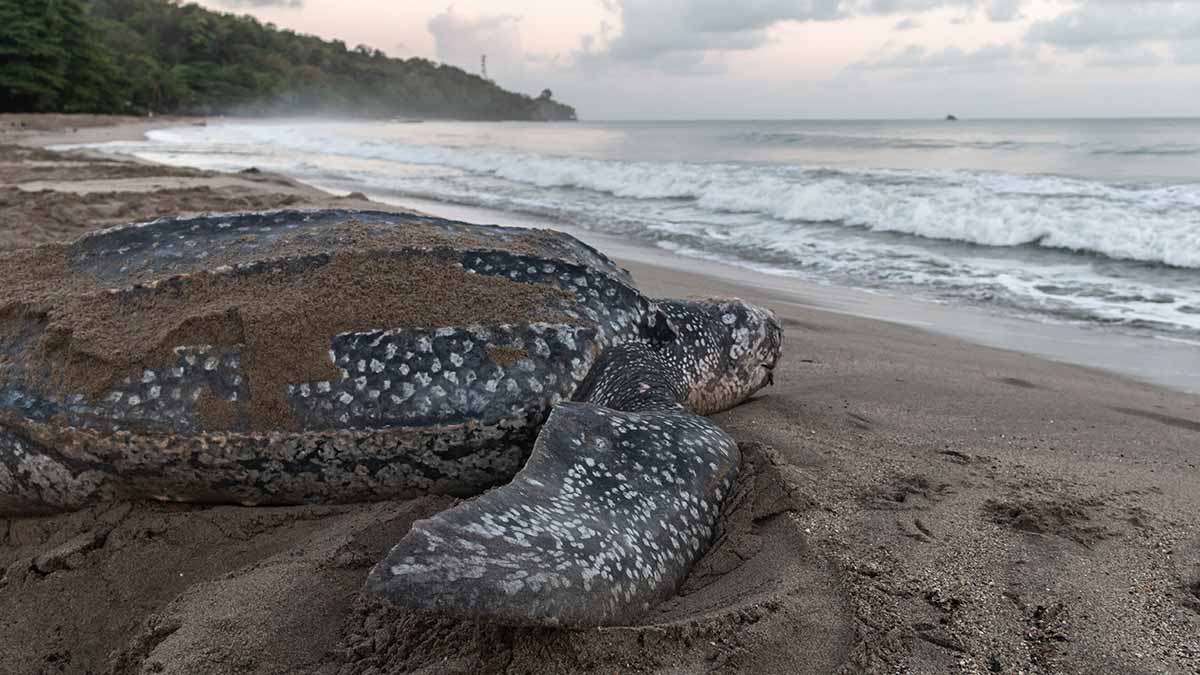
Leatherbacks primarily feed on jellyfish. Gelatinous creatures like jellyfish can be difficult to swallow, but these turtles have evolved spines in their throat to catch and hold down their food. Leatherbacks can dive deeper than other sea turtles, reaching depths of up to 4,000 feet where they hold their breath for up to 85 minutes to feed on salps that live in deep water.
Leatherbacks have a longer migration route than other sea turtle species, traveling an average of 3,700 miles each way. They feed in colder waters and then migrate to tropical locations to lay their eggs. Leatherbacks have been observed traveling all the way from northern Canada to the Caribbean.
Olive Ridley Sea Turtle
Named for the olive green color of their shells, this turtle species is the second-smallest on the planet. Identifying an olive ridley sea turtle can be tricky because they look similar to Kemp’s ridleys. Olive ridleys are slightly bigger than their cousins, with a heart-shaped shell and two claws on each flipper, but they have fewer scutes (hexagonal scales) on their shells.
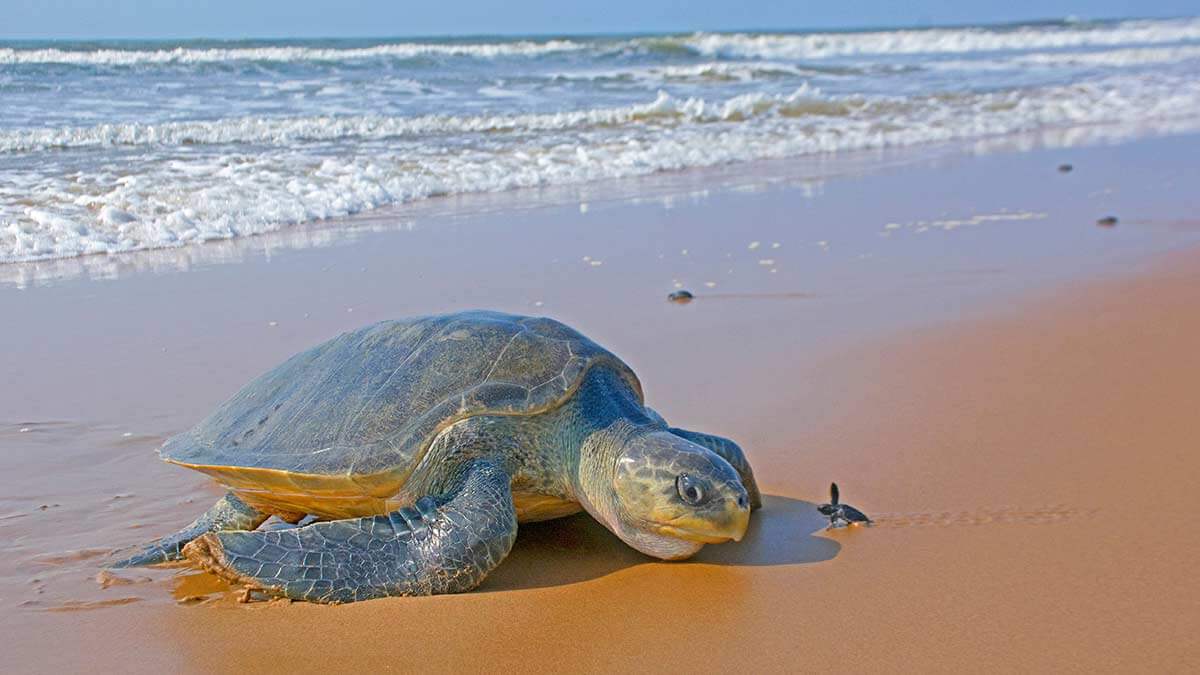
Olive ridley sea turtles are omnivorous, meaning their diet consists of both meat and plants. They enjoy eating mollusks, algae, lobster, crabs, and sea squirts. These turtles can dive up to 500 feet deep to feed on invertebrates that live on the ocean floor.
Olive ridley sea turtles can be found in the Atlantic, Pacific, and Indian oceans. They are mostly pelagic, meaning they spend most of their life in the open ocean. Cargo ships often spot these turtles upwards of 2,400 miles from shore. They can be found in the coastal waters of at least 80 countries, but they only engage in mass nesting behavior on select beaches in Mexico, Costa Rica, Nicaragua, and India.
Kemp’s Ridley Sea Turtle
The Kemp’s ridley sea turtle is the smallest and most endangered sea turtle species. Once thought to be a hybrid between a hawksbill and loggerhead sea turtle, the Kemp’s ridley is recognized as an independent species, most closely related to olive ridleys. While they look quite similar, Kemp’s ridley are slightly smaller than olive ridley sea turtles. Their shell is oval-shaped and is almost as wide as it is long. Kemp’s ridley turtles, like hawksbills, have a triangular head and hooked beak, perfect for crushing their prey.
A Kemp’s ridley sea turtle’s food of choice is crab. Occasionally, these turtles will eat shrimp, jellyfish, snails, clams, or sea stars when crabs are unavailable.
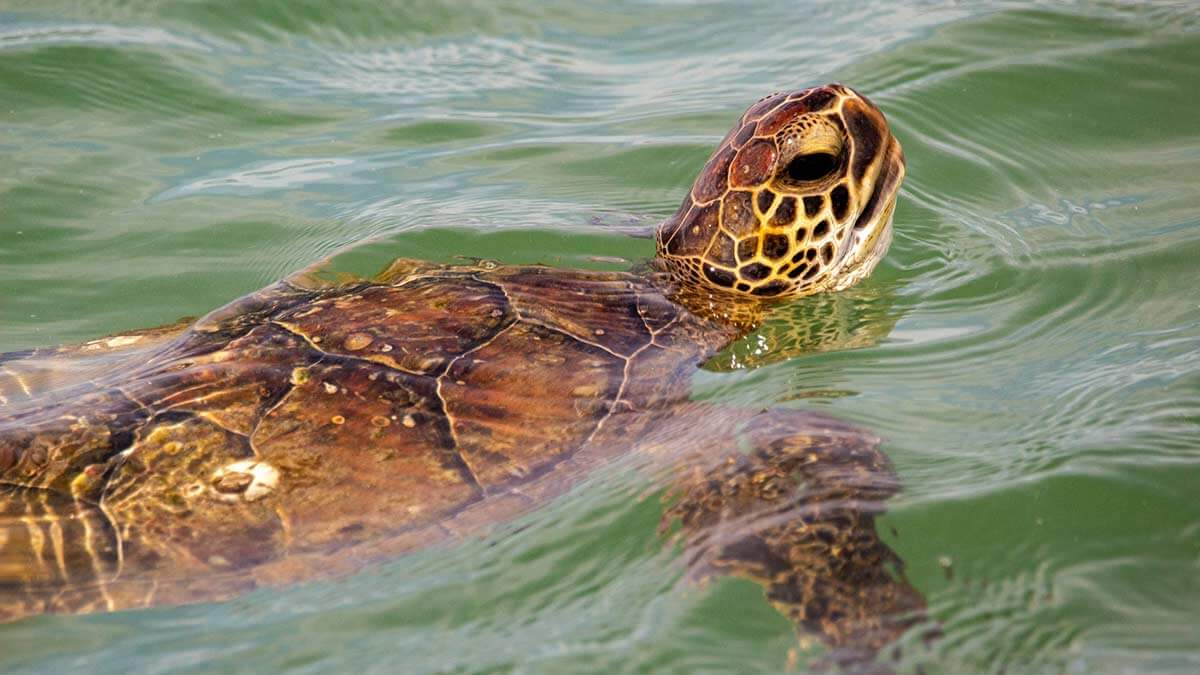
Kemp’s ridley sea turtles are only found in the Gulf of Mexico and along the Atlantic coast of the United States. Compared to other sea turtle species, they occupy a very small area of the globe. Unlike their olive ridley cousins, Kemp’s ridley turtles prefer to live in shallow waters with muddy or sandy bottoms. Some Kemp’s ridleys migrate, but others prefer to live in one area, feeding just offshore and occasionally heading to the beach to nest. Regardless of where they live, all Kemp’s ridley turtles engage in mass nesting behavior, choosing to nest only in northeastern Mexico.
Green Sea Turtle
Green sea turtles are the only herbivorous sea turtle species, meaning they do not hunt for food but prefer to graze on plants and algae. Green sea turtles are among the most recognized sea turtles in the world, with popular movie characters like Finding Nemo’s Crush modeled in their likeness. These turtles have an olive-colored shell and a yellow or white underside. A distinct identifying feature of a green sea turtle is the two scales between the eyes.
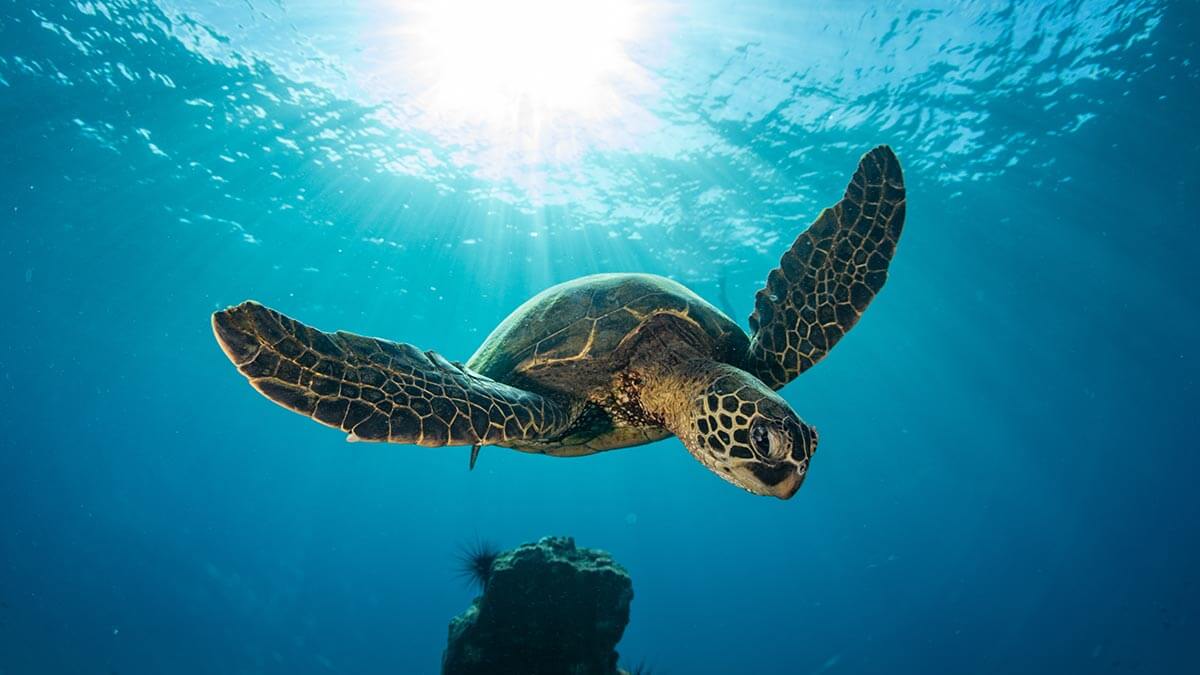
A green sea turtle’s serrated beak makes it easy for them to cut seagrass fronds and scrape algae from rocks. As babies, these turtles are omnivorous, feeding on plant and animal matter in sargassum patches in the open ocean. Once they grow large enough to venture out into the ocean and travel to seagrass beds, green sea turtles eat a predominantly vegetarian diet.
You can find green sea turtles in the Mediterranean Sea as well as the Indian, Atlantic, and Pacific oceans. As adults, they tend to live in shallow waters near the shore where seagrass is abundant. Green sea turtles have been spotted as far north as Alaska, but most commonly reside in temperate or subtropical areas. They are a tourist attraction in many destinations, such as the Hawaiian islands, where turtle sightings are common on snorkeling or diving trips.
Loggerhead Sea Turtle
Loggerhead sea turtles are named for their distinctly large heads which evolved to support their powerful jaws. Loggerheads use their jaws to easily crush the hard shells of prey like sea snails, whelks, and conch. Loggerheads’ shells are heart-shaped, with a reddish brown coloration on the top and a pale yellow underside.
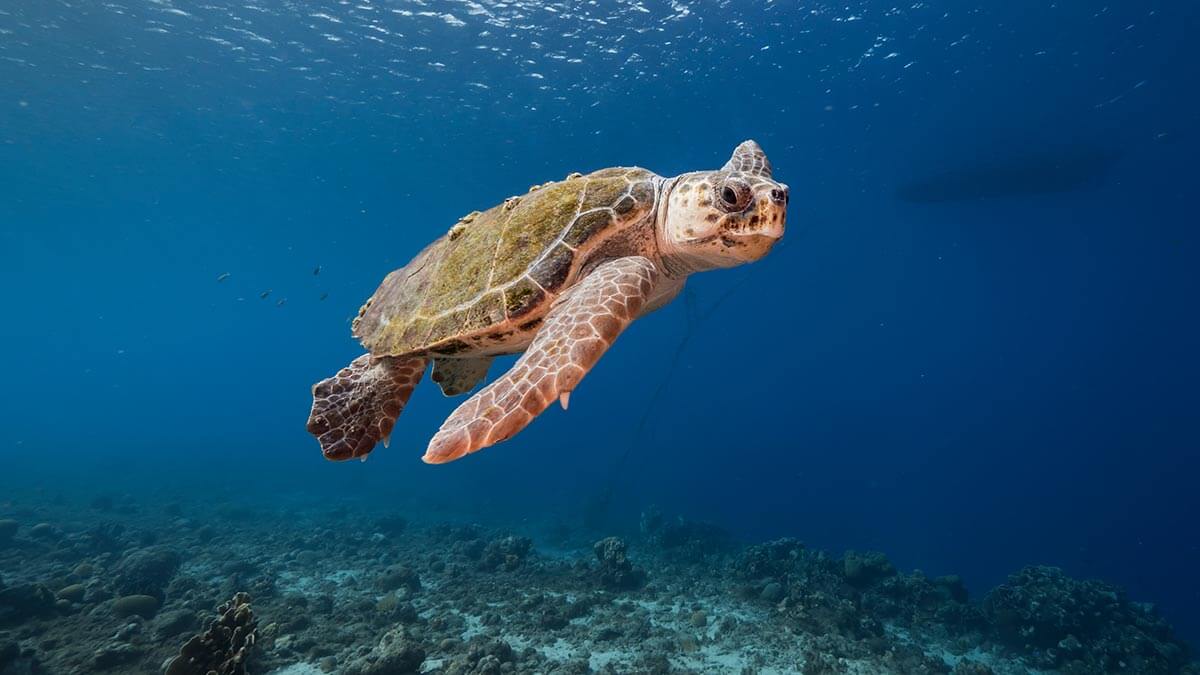
Loggerheads can be found in the Atlantic, Pacific, Indian Ocean, and Mediterranean Sea. Loggerheads in the Pacific undergo a nearly 8,000-mile migration from their feeding grounds in Baja California, Peru, and Chile to nesting beaches in Japan. These turtles spend the first 20 years of their lives in the open ocean, feeding on plants, animals, and sometimes trash that floats by. Once they reach maturity, they migrate to shallower waters where they eat larger prey.
Flatback Sea Turtle
Flatback sea turtles are named for the unique flat shape of their shell, which looks unlike any other sea turtle species. Flatbacks prefer shallow, murky water, rarely entering water deeper than 60 meters to feed.
Flatbacks enjoy feeding on soft prey like sea cucumbers and jellyfish. They occasionally eat seaweed, mollusks, prawns, and other invertebrates. Flatbacks have the smallest range of all sea turtle species, residing on the Australian continental shelf, and occasionally feeding in waters off of Papua New Guinea. This species exclusively nests on Australian beaches.
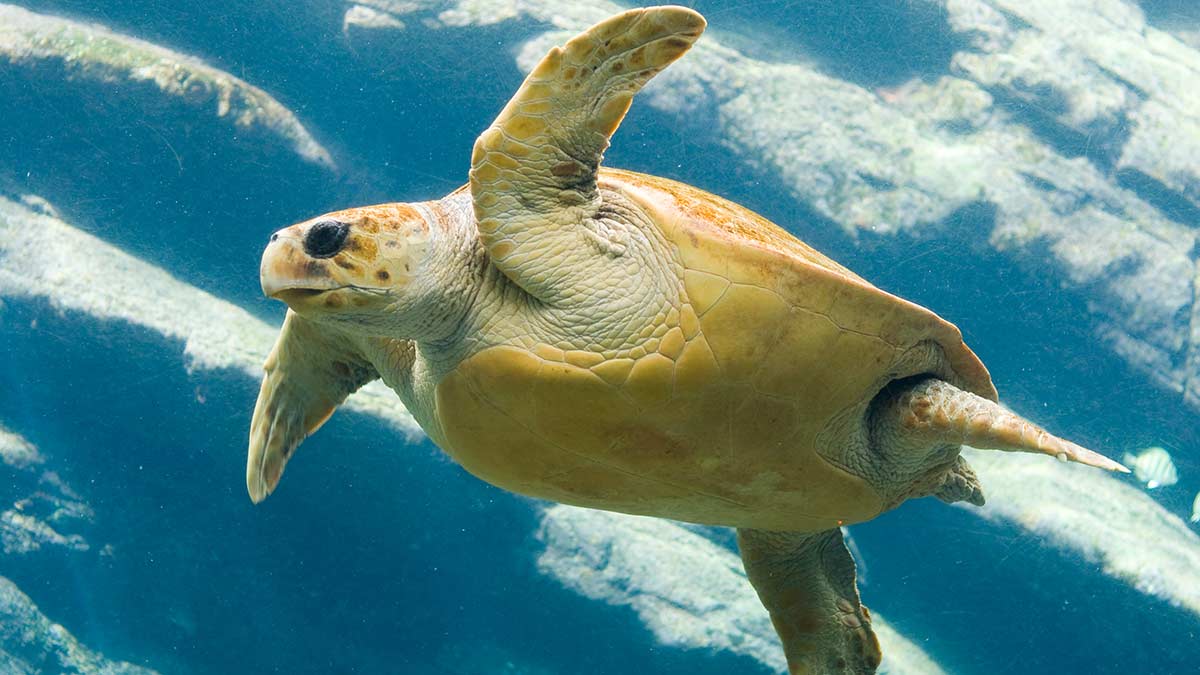
Flatbacks are the only sea turtle species not technically classified as endangered; however, this is due to a lack of data about the population. These turtles live in murky, remote waters, making them difficult for scientists to track.
Sea Turtle Biology & Behavior
Sea turtles are highly specialized to thrive in ocean environments. Although they breathe air, they have unique biological adaptations that help them spend long periods underwater, where they hunt, rest, and mate.
How Do Sea Turtles Breathe?
Sea turtles are reptiles, which means they have lungs to breathe air and must come on land to lay their eggs. Though they must swim to the surface to breathe, sea turtles spend most of their life underwater. Turtles can hold their breath for up to seven hours when they are resting, slowing their heart rate down to reduce the amount of oxygen their bodies need.
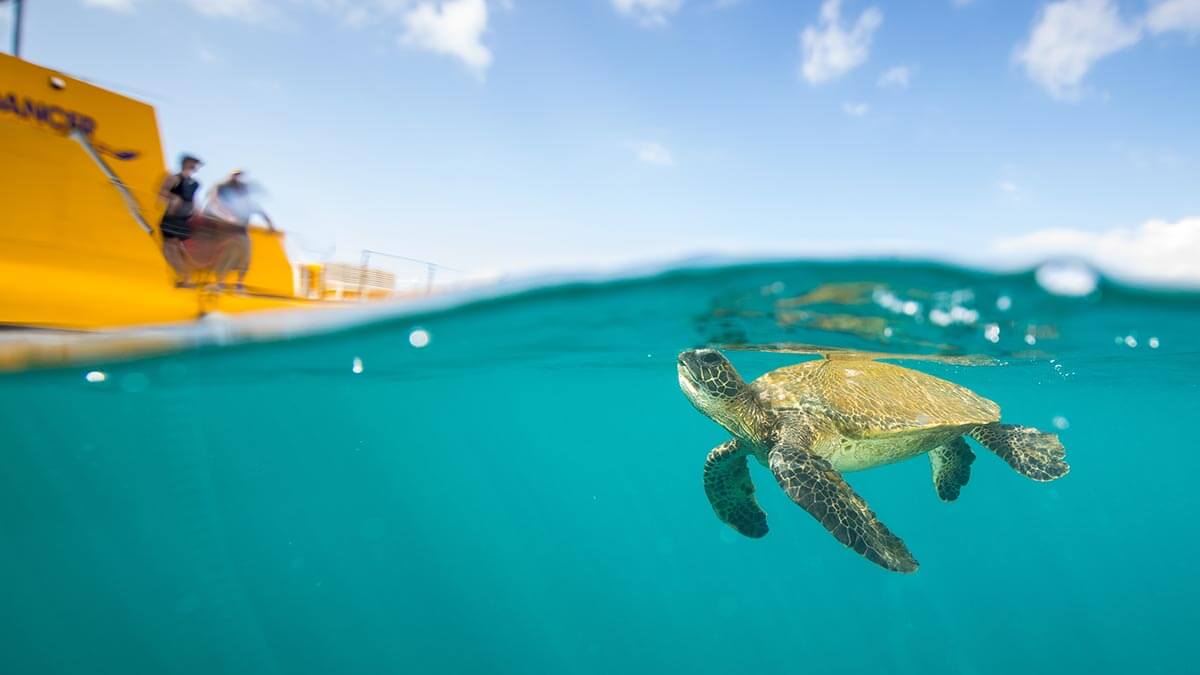
How Do Sea Turtles Sleep?
Turtles can sleep up to 11 hours a day, coming up for air between naps. In deeper waters where they cannot find rocks to rest between, sea turtles sleep on the water’s surface. During mating season, turtles enjoy sleeping on the beach, which helps them regulate their body temperature.
What Do Sea Turtles Eat?
Most turtles spend the majority of their lives at sea, hunting for food until it is time to migrate to the beach where they were born to nest. Adult sea turtles eat jellyfish, crustaceans, algae, or seagrass. A sea turtle’s diet varies by species. Baby sea turtles mostly feed on small animals or fronds of seaweed in the open ocean.
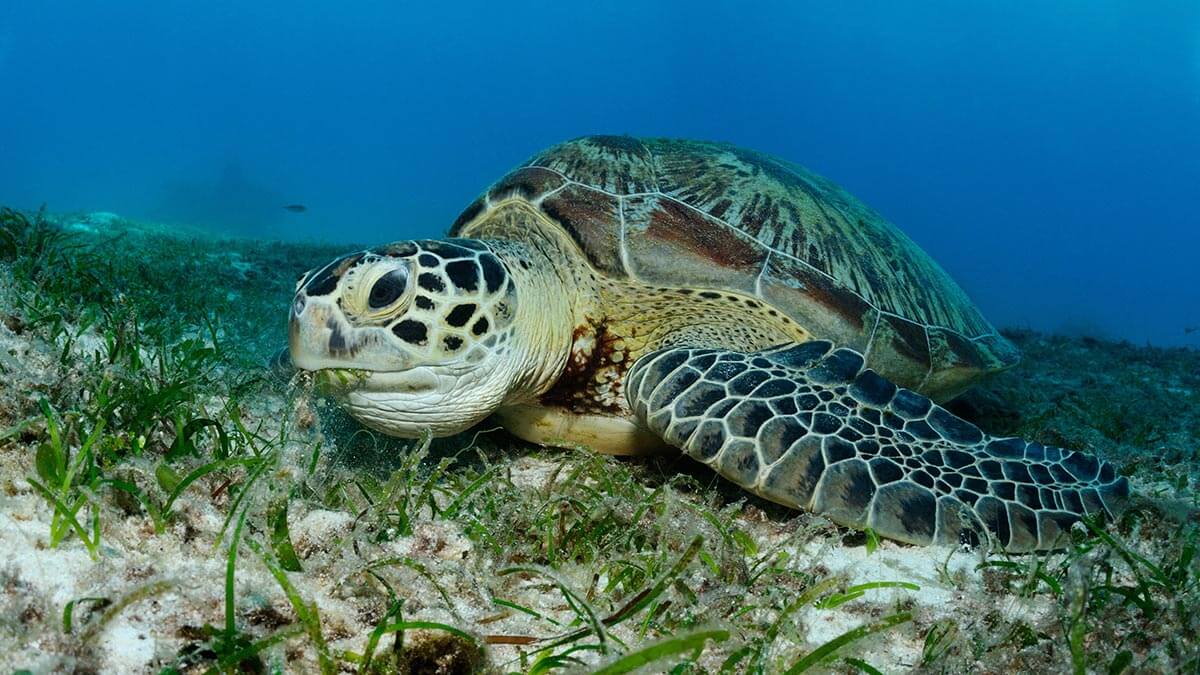
What Are Sea Turtles Main Predators?
As a prey species, turtles have stronger senses than humans, meaning they can sense when danger is coming much faster than we can. A big part of a turtle’s day is spent on high alert, making sure they have a place to hide from predators. Sea turtles’ main predators are sharks, though they are sometimes eaten by orcas and large fish like groupers and barracudas.
How Long Do Sea Turtles Live?
Sea turtles are slow-growing animals and most species do not reach maturity until they are at least 20 years old. They have been known to live upwards of 80 years, though their actual lifespan has yet to be determined. It is believed that there may be some turtles alive today that are almost 100 years old.
Sea Turtle Mating and Nesting
Nesting and mating seasons vary by species and location but generally occur in warmer months. The graphic below shows when and where nesting seasons are for each sea turtle species.
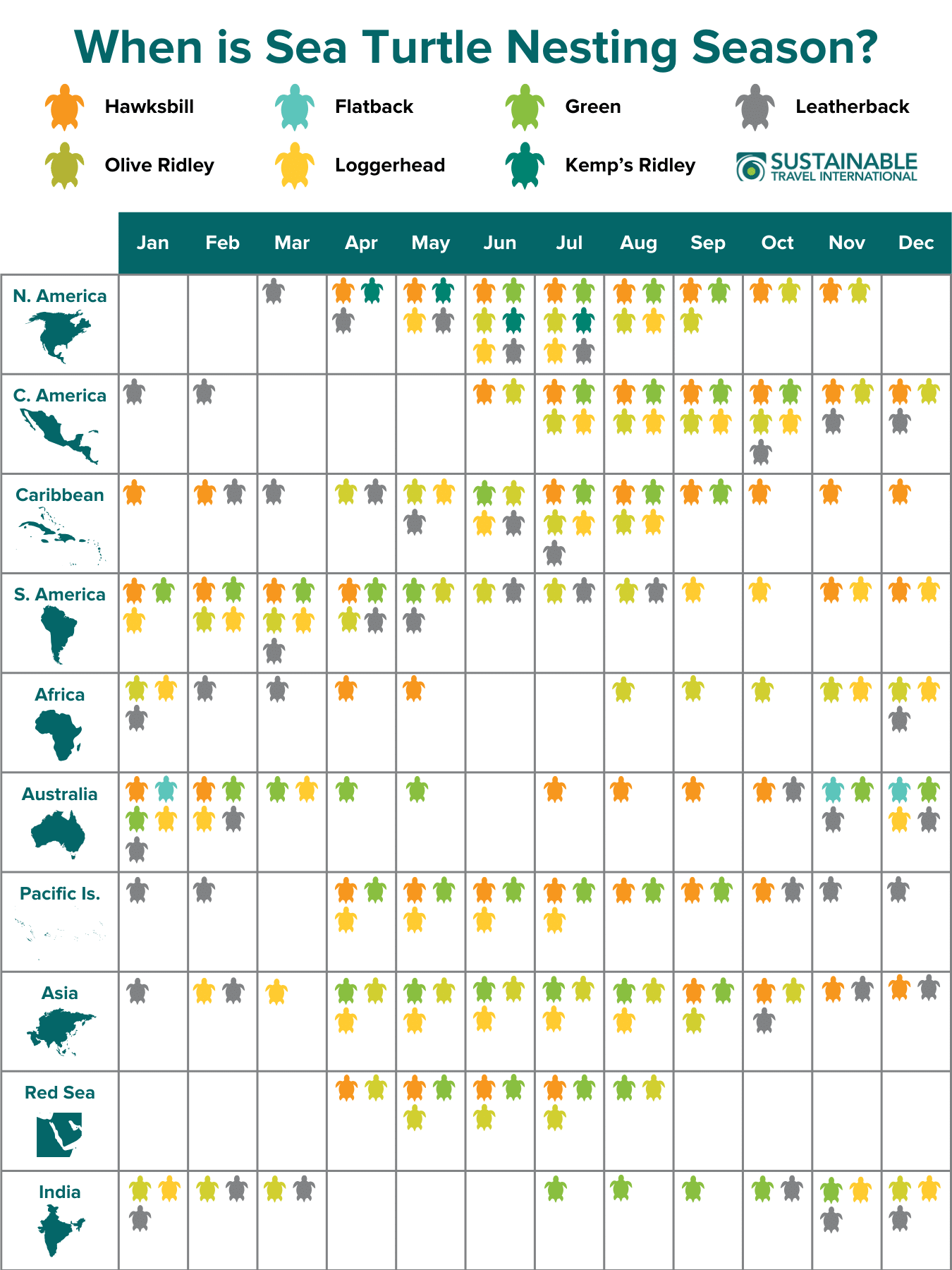
While nesting occurs annually, individual sea turtles only mate and nest an average of every two to three years. After mating, females head to the beach up to three times per season to lay eggs. Females tend to return to the beaches where they were born to nest. They find these nesting sites thanks to a special sixth sense. Turtles can feel the Earth’s magnetic field, giving them a built-in compass that helps them find their way back to their home beach.
Turtles can travel thousands of miles to find the perfect spot to nest, with some species more particular about where they lay their eggs than others. Once they find the perfect spot to lay their eggs, female sea turtles bury them in the sand. Leatherbacks are the pickiest nesters, and beaches with too much clutter are deemed unsuitable for nest building. Female leatherbacks who do not find a clean nesting site during their breeding season will not nest at all. It can be up to five years before a leatherback nests again, meaning one failed nesting season can greatly affect the species’ population.
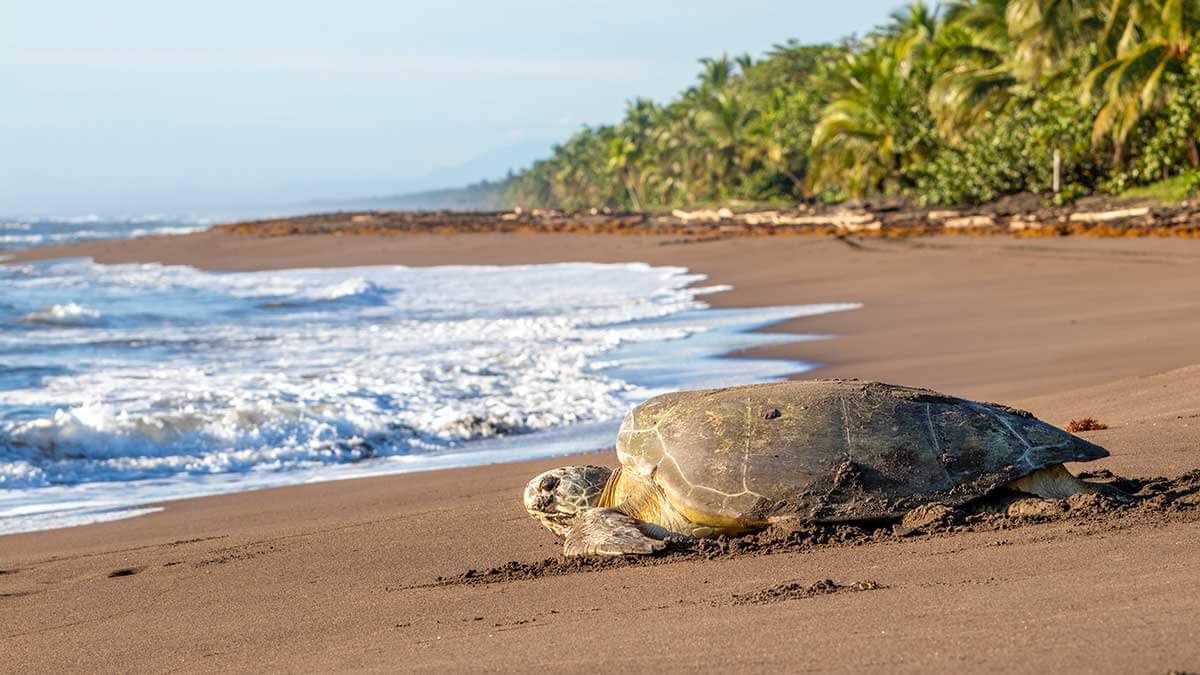
Most sea turtle species lay their eggs at night, except Kemp’s ridley turtles who prefer to nest in daylight. Though the number of eggs varies by species, sea turtles lay an average of 100 eggs per nest. Loggerheads lay the most eggs, while flatbacks lay the least. You can spot a sea turtle nest by looking for piles of loose sand next to turtle tracks along the beach. The longer the nest has been incubating, the harder it is to spot because sand gets compacted over the eggs with time.
The turtle eggs incubate in the warm sand for an average of 2 months before they hatch. Like many reptiles, the temperature of a sea turtle nest determines the gender of the babies that hatch from it, with warmer nests producing all female turtles and cooler nests only producing males. As climate change raises the planet’s temperature, there will be fewer male turtles when it comes time for future generations to mate.
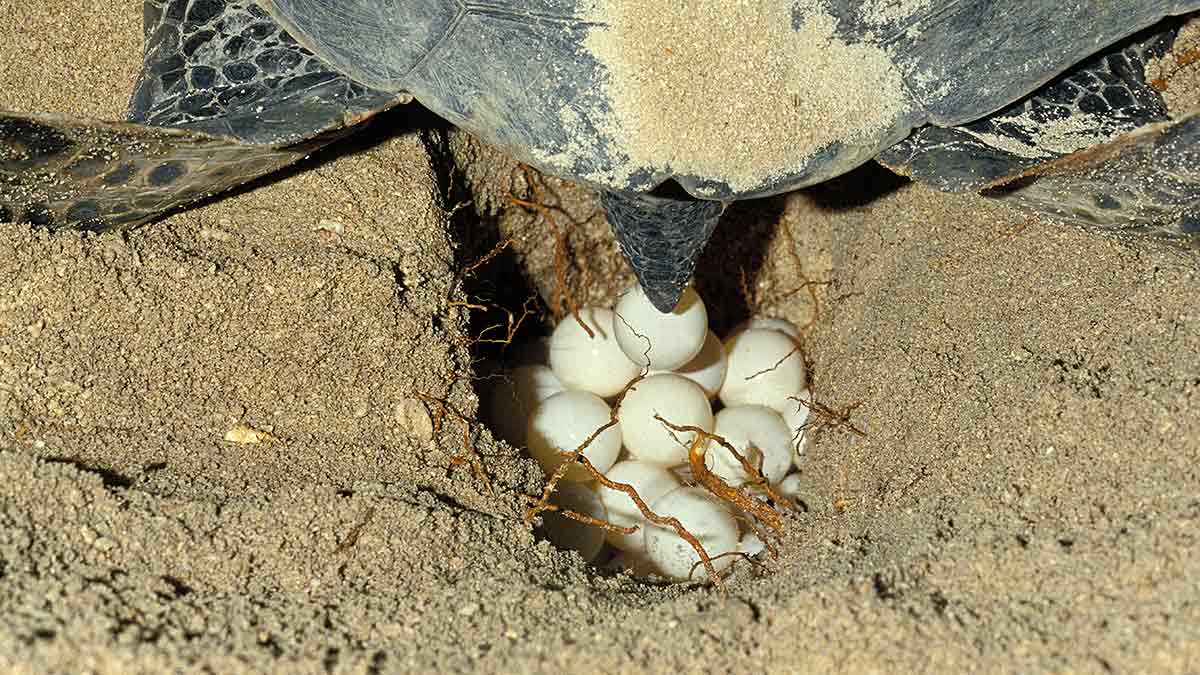
While most sea turtle species nest individually, both ridley species engage in mass nesting events, called arribadas, where tens of thousands of individuals descend on the beach to nest at once. These mass nesting events take place in Central and South America, as well as India. The largest arribadas take place in Odisha, India, where over 500,000 individuals have been observed nesting at once. As eggs break, bacteria grow in the soil, which can pose a threat to nearby nests.
To combat this problem, scientists in Playa Ostional, Costa Rica, have teamed up with the local community to reduce the number of broken eggs on the beach and create a new source of income for residents. Scientists and trained volunteers count the nesting turtles and inform village officials how many eggs can be harvested with special permits from the government. Thanks to their collaborative efforts, the mortality rate for olive ridley hatchlings has reduced significantly since the project began. Tourists can watch nesting turtles on the beach with a certified guide and head to a local cafe to try sangrita, a raw turtle egg with a few dashes of hot sauce meant to be slurped down from a shot glass.
There are also nesting projects that benefit solitary nesting sea turtles. In Wrightsville, North Carolina, volunteers protect turtle nests, day and night, until hatchlings emerge. If beachgoers see a turtle, a nest, or turtle tracks, they can text a city hotline that dispatches a volunteer to the site to watch over the animal or guard the nest. This program prevents poaching and helps people avoid setting up their beach chairs over an active nest. In Trinidad and Tobago, the nonprofit organization Nature Seekers trains locals to be turtle tour guides and patrol leaders. The program has reduced unemployment in the country, protected countless turtles from poachers, and contributed to the success of a long-term turtle tagging effort.
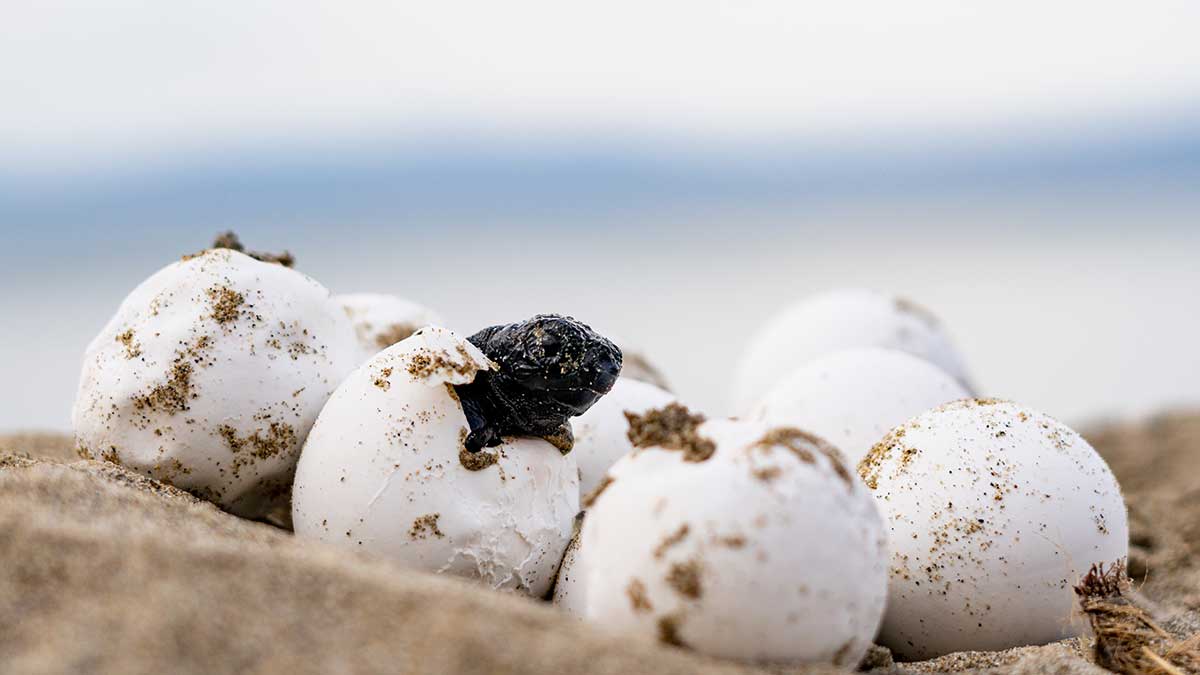
Baby Sea Turtles
After the eggs incubate for 40 to 70 days, baby turtles hatch. Once they break out of their eggs, baby sea turtles are called hatchlings.
The newly hatched turtles begin digging upwards to the surface, waiting for nightfall to run to the ocean. Baby sea turtles know how to travel to the ocean because they are born with a strong instinct to head straight for the sea as fast as they can, preparing them for the dangerous journey. When hatchlings run toward the water, they use the slope of the beach, the sound of the waves, and the light refracting off of the horizon as a guide.
When artificial lights shine near these nests, baby turtles can get confused, mistaking the lights for the ocean, and travel in the wrong direction. Resorts, beach bars, and other businesses near nesting beaches should use turtle-friendly lights to reduce this problem.
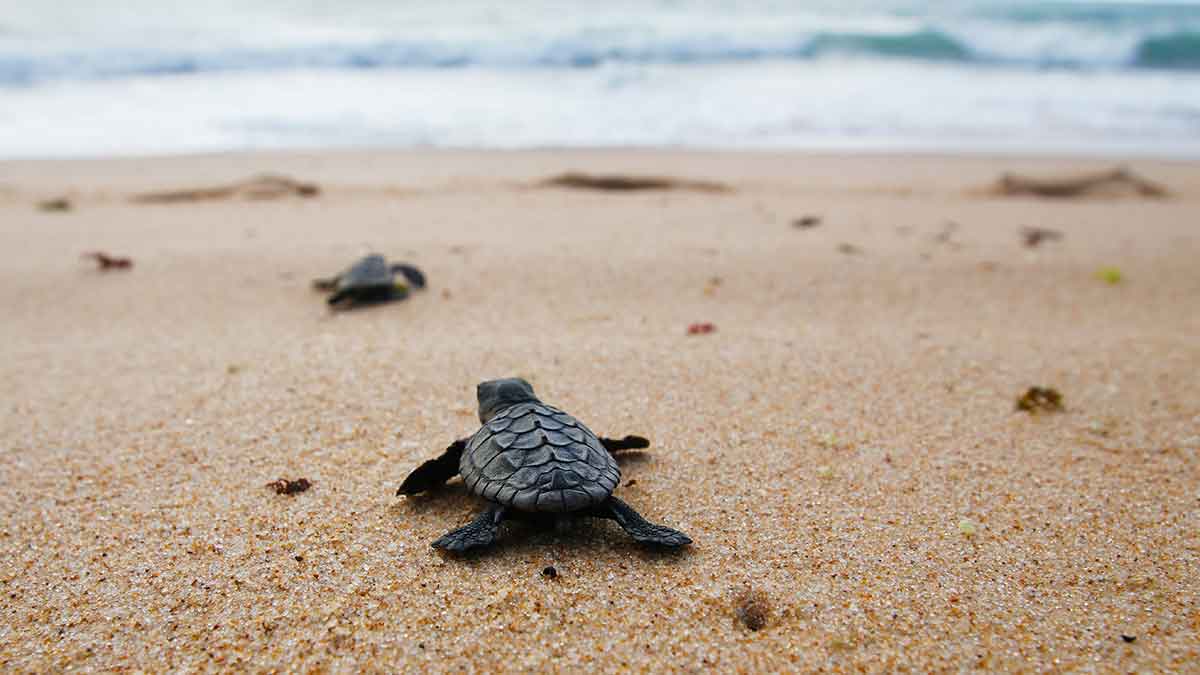
After they reach the water, baby turtles begin what is known as a swimming frenzy, where they swim as fast as they can for days until they leave the dangerous nearshore waters. Most hatchling turtles spend the first part of their lives in the open ocean, hanging onto clumps of seaweed as they drift along the currents. From the moment they hatch, baby sea turtles face considerable obstacles, and scientists estimate that only 1 in 1,000 hatchlings survive to adulthood.
Learn How to Protect These Incredible Animals
The seven species of sea turtles are uniquely adapted to thrive in their environments. Their lovable looks, interesting life cycles, and calm nature have captivated countless people, inspiring a large conservation movement. Sea turtles are still in danger of extinction. Still, we can all work together to save them by continuing the conversation about how important they are to ecosystems, economies, local communities, and tourists.
We hope this blog taught you a few new facts about sea turtles. Learn more about why sea turtles are important, why they are endangered, and how you can help protect them in our next blog.
Free Sustainable Travel Tips List

